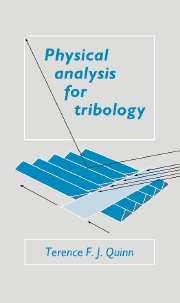Book contents
- Frontmatter
- Contents
- Preface
- Nomenclature list
- 1 Tribology
- 2 Macroscopic physical techniques
- 3 Microscopic physical techniques for studying atomic arrangement
- 4 Microscopic techniques for studying atomic structure
- 5 The analysis of lubricant films
- 6 The analysis of surface temperatures in tribo-systems
- 7 The analysis of pitting failures in tribo-systems
- 8 The analysis of oxidational wear in tribo-systems
- 9 The application of physical techniques to selected ceramic tribo-systems
- References
- Index
5 - The analysis of lubricant films
Published online by Cambridge University Press: 29 October 2009
- Frontmatter
- Contents
- Preface
- Nomenclature list
- 1 Tribology
- 2 Macroscopic physical techniques
- 3 Microscopic physical techniques for studying atomic arrangement
- 4 Microscopic techniques for studying atomic structure
- 5 The analysis of lubricant films
- 6 The analysis of surface temperatures in tribo-systems
- 7 The analysis of pitting failures in tribo-systems
- 8 The analysis of oxidational wear in tribo-systems
- 9 The application of physical techniques to selected ceramic tribo-systems
- References
- Index
Summary
The analysis of extreme-pressure lubricant films formed in the presence of typical disulphide additives
Introduction
In this section of our chapter on the analysis of lubricant films, we will be concerned with the use of physical methods of analysis to investigate the mechanisms whereby some selected disulphides provide protection under conditions of sliding which would otherwise have resulted in the breakdown or seizure of the tribo-system if the disulphides were not present as ‘extreme-pressure’ additives in the lubricant. There are, in fact, two types of extreme-pressure additives, one that prevents catastrophic failure when a tribo-system is suddenly subjected to unexpectedly high loads (such an additive is truly called an ‘extreme-pressure’ additive), and another that reduces the wear to an ‘acceptable’ level in a system designed to work close to the limits of lubrication, for example a hypoid gear system. We call the latter type of lubricant additive an ‘anti-wear’ additive, for obvious reasons. Some tribologists suggest we should drop the word ‘pressure’ in the generic word for the whole family of lubricant additives and merely call them ‘extreme-temperature’ additives. As we shall see, the temperature between the wearing interfaces is indeed an important factor in the mechanisms whereby extreme-pressure lubricant additives provide protection of those interfaces from the incidence of severe way.
- Type
- Chapter
- Information
- Physical Analysis for Tribology , pp. 202 - 290Publisher: Cambridge University PressPrint publication year: 1991

